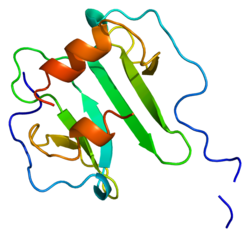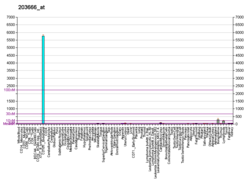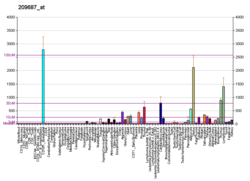CXCL12
CXCL12(C-X-C motif chemokine ligand 12)もしくはSDF-1(stromal cell-derived factor 1)は、ヒトでは10番染色体に位置するCXCL12遺伝子にコードされるケモカインである[5]。CXCL12は多くの組織や細胞種において普遍的に発現している[6]。SDF-1にはSDF-1α、βと呼ばれる種類が存在し、ケモカインファミリーに属する。ケモカインは白血球を活性化し、多くの場合リポ多糖、TNF、IL-1などの炎症性刺激によって誘導される。ケモカインは2つのジスルフィド結合を形成する4つの保存されたシステイン残基によって特徴づけられ、CXCL12はシステイン残基のペアが1アミノ酸によって隔てられているCXCサブファミリーに属する[5]。CXCL12シグナルはいくつかのがんでも観察される[7][8]。CXCL12遺伝子には27種類のSNPが含まれており、冠動脈疾患のリスクの増加と関係している[9]。
構造
[編集]遺伝子
[編集]CXCL12遺伝子は10番染色体のバンド10q11.1に位置し、9つのエクソンから構成される[5]。この遺伝子からは選択的スプライシングによって7種類のアイソフォームが産生される[10]。
タンパク質
[編集]CXCL12/SDF-1はインタークリンα(CXCケモカイン)ファミリーに属する[10]。同じ遺伝子からの選択的スプライシングによって、SDF-1α/CXCL12aとSDF-1β/CXCL12bの2つの形態で産生される[11]。ケモカインは保存された4つのシステイン残基によって特徴づけられ、これらは2つのジスルフィド結合を形成している。CXCL12はCXCケモカインに属し、システインの最初のペアは1アミノ酸によって隔てられている。CXCL12のN末端の最初の8残基は受容体活性化のための結合部位として機能するが、受容体の活性化に直接関与しているのはLys1とPro2のみである。一方、ループ領域に位置するRFFESHモチーフ(12–17番残基)は受容体への結合のためのドッキング部位として機能する[12]。
機能
[編集]マウスでは、CXCL12は脳、胸腺、心臓、肺、肝臓、腎臓、脾臓、血小板、骨髄など多くの組織で発現している[13][14]。CXCL12はリンパ球に対して強い誘引効果を示す[15][16][17][18]。胚発生の間、CXCL12は胎児肝臓から骨髄への造血系細胞の移動や大血管の形成を指示する。また、CXCL12シグナルはB細胞上のCD20の発現を調節することも示されている。CXCL12は間葉系幹細胞に対する誘引効果も示し、炎症性骨破壊部位で発現して破骨細胞発生に対する抑制効果を媒介している[19]。
成体では、CXCL12はCXCR4依存的機構によって骨髄から血管内皮前駆細胞(EPC)をリクルートし、血管新生に重要な役割を果たす[20]。
CXCR4はCXCL12の受容体であり、以前にはLESTRもしくはfusinとも呼ばれていた[15]。CXCL12-CXCR4間相互作用は(他のケモカインやその受容体とは異なり)排他的であると考えられてきたが、近年ではCXCL12がCXCR7(ACKR3)にも結合する可能性が示唆されている[21][22][23]。CXCL12はHIV-1の細胞進入の際の主要なコレセプターとなっているCXCR4を遮断することで、CXCR4-tropic HIV-1株に対する内因性の阻害因子として機能する[24]。
中枢神経系
[編集]胚発生時には、CXCL12は神経細胞の移動を指示することで小脳の形成に関与している[25]。中枢神経系においては、CXCL12は細胞増殖、神経発生(神経組織の発生と成長)のほか、神経炎症にも寄与している。神経前駆細胞(NPC)は、グリア細胞と神経細胞に分化する幹細胞である。CXCL12は脳内の病変部位へのこれらの細胞の遊走、特に長距離の遊走を促進する。損傷部位に到着したNPCは、幹細胞を基盤とした組織修復を開始する[26]。CXCL12/CXCR4軸は軸索や神経突起に対するガイダンスキューとなり、神経突起の成長や神経発生を促進する[27]。他のケモカインと同様、CXCL12は炎症に寄与する細胞遊走にも関与している。中枢神経系においては、CXCL12は血液脳関門を越えて白血球を誘引することで神経炎症に関与する[26]。CXCL12の過剰産生や蓄積は有害であり、その結果生じた炎症は重大な影響を引き起こす可能性がある[28]。
臨床的意義
[編集]ヒトでは、CXCL12はいくつかの器官と関係した広範囲の医学的状態と関係していることが示唆されている[29]。さらに、CXCL12シグナルはCXCR7シグナルとともに、膵臓がんの進行への関与が示唆されている[7]。尿路系においては、CXCL12プロモーターのメチル化とPD-L1の発現は前立腺全摘除術後の患者の前立腺癌の生化学的再発に対する強力な予後バイオマーカーとなり、CXCL12のメチル化が監視療法(アクティブサーベイランス)戦略に有用であるかどうかを確認するためのさらなる研究が進行している[30]。メラノーマ関連線維芽細胞はアデノシンA2B受容体の刺激によって線維芽細胞増殖因子やCXCL12の発現が刺激され、腫瘍微小環境の形成に寄与する[8]。
臨床マーカー
[編集]CXCL12遺伝子を含む27遺伝子座に基づく多遺伝子リスクスコア研究によって、冠動脈疾患イベントの発生や再発のリスクの高い人物や、スタチン療法によって臨床的有用性が得られる人物が特定されている。この研究は住民コホート研究(the Malmo Diet and Cancer study)、そして一次予防コホート(JUPITER、ASCOT)と二次予防コホート(CARE、PROVE IT-TIMI 22)のランダム化比較試験に基づいている[9]。
多発性硬化症
[編集]多発性硬化症(MS)では、免疫系と神経系の相互作用の欠陥によって神経症状が引き起こされる。MSは体内の免疫系が中枢神経系を攻撃することで生じた脱髄によって特徴づけられる。MS患者の脳脊髄液ではCXCL12濃度の上昇が観察される。CXCL12は血液脳関門を通過して軸索損傷に寄与する神経炎症を引き起こし、MSの進行に寄与する[31]。
アルツハイマー病
[編集]CXCL12はMS患者には有害である可能性がある一方で、近年の研究ではこのケモカインがアルツハイマー病の進行の低下に有用である可能性が示唆されている。アルツハイマー病は認知機能が低下する認知症の最も一般的な形態である。アルツハイマー病の主な特徴は、β-アミロイドからなるプラーク(アミロイド斑)の蓄積である。マウスでは、こうしたプラークが生じたマウスに対するCXCL12の神経保護効果が示されている。PAK(p21-activated kinase)は樹状突起スパインの維持と関係したタンパク質であり、シナプスが軸索から情報を受け取る際に必要不可欠である。アルツハイマー病患者ではPAKの誤局在が生じているが、CXCL12処理によってこの誤局在が抑制されることがマウスでは示されている[32]。さらに、このCXCL12による前処理はアミロイド斑の存在によって引き起こされるアポトーシスや酸化損傷を低下させる[32]。
薬剤標的として
[編集]ケモカインやケモカイン受容体は形態形成、血管新生、免疫応答など複数の過程を調節しているため、薬剤開発の標的となると考えられている。特発性肺線維症患者の肺ではCXCR4の高発現がみられることが臨床試料から示されている。さらに、CXCL12/CXCR4が肺線維症の発症と関係していることを示す実験的証拠も得られている[33]。消化管領域では、慢性膵炎の治療においてCXCL12-CXCR4軸が抗線維化治療の標的として研究が行われている[34]。乳がんのマウスモデルでは、CXCL12の受容体であるCXCR4をプレリキサホル(AMD-3100)によって遮断することで、コンブレスタチンの有効性が高まることが示されており、おそらくマクロファージが腫瘍へリクルートされるのを防ぐことで機能していると考えられている[35]。また、AMD-3100はG-CSFとともに造血幹細胞の血流への動員に広く用いられており、骨髄移植に向けた採取を可能にしている[36]。
出典
[編集]- ^ a b c GRCh38: Ensembl release 89: ENSG00000107562 - Ensembl, May 2017
- ^ a b c GRCm38: Ensembl release 89: ENSMUSG00000061353 - Ensembl, May 2017
- ^ Human PubMed Reference:
- ^ Mouse PubMed Reference:
- ^ a b c “CXCL12 C-X-C motif chemokine ligand 12 [Homo sapiens (human) - Gene - NCBI]” (英語). www.ncbi.nlm.nih.gov. 2023年1月28日閲覧。
- ^ “BioGPS - your Gene Portal System”. biogps.org. 2016年10月11日閲覧。
- ^ a b Guo, Jun-Chao; Li, Jian; Zhou, Li; Yang, Jian-Yu; Zhang, Zhi-Gang; Liang, Zhi-Yong; Zhou, Wei-Xun; You, Lei et al. (2016-09-20). “CXCL12-CXCR7 axis contributes to the invasive phenotype of pancreatic cancer”. Oncotarget 7 (38): 62006–62018. doi:10.18632/oncotarget.11330. ISSN 1949-2553. PMC 5308707. PMID 27542220.
- ^ a b Sorrentino, Claudia; Miele, Lucio; Porta, Amalia; Pinto, Aldo; Morello, Silvana (2016-09-27). “Activation of the A2B adenosine receptor in B16 melanomas induces CXCL12 expression in FAP-positive tumor stromal cells, enhancing tumor progression”. Oncotarget 7 (39): 64274–64288. doi:10.18632/oncotarget.11729. ISSN 1949-2553. PMC 5325441. PMID 27590504.
- ^ a b Mega, J. L.; Stitziel, N. O.; Smith, J. G.; Chasman, D. I.; Caulfield, M.; Devlin, J. J.; Nordio, F.; Hyde, C. et al. (2015-06-06). “Genetic risk, coronary heart disease events, and the clinical benefit of statin therapy: an analysis of primary and secondary prevention trials”. Lancet (London, England) 385 (9984): 2264–2271. doi:10.1016/S0140-6736(14)61730-X. ISSN 1474-547X. PMC 4608367. PMID 25748612.
- ^ a b “CXCL12 - Stromal cell-derived factor 1 precursor - Homo sapiens (Human) - CXCL12 gene & protein”. UniProt. 2023年1月28日閲覧。
- ^ De La Luz Sierra, Maria; Yang, Fuquan; Narazaki, Masashi; Salvucci, Ombretta; Davis, David; Yarchoan, Robert; Zhang, Hongwei H.; Fales, Henry et al. (2004-04-01). “Differential processing of stromal-derived factor-1alpha and stromal-derived factor-1beta explains functional diversity”. Blood 103 (7): 2452–2459. doi:10.1182/blood-2003-08-2857. ISSN 0006-4971. PMID 14525775.
- ^ Crump, M. P.; Gong, J. H.; Loetscher, P.; Rajarathnam, K.; Amara, A.; Arenzana-Seisdedos, F.; Virelizier, J. L.; Baggiolini, M. et al. (1997-12-01). “Solution structure and basis for functional activity of stromal cell-derived factor-1; dissociation of CXCR4 activation from binding and inhibition of HIV-1”. The EMBO journal 16 (23): 6996–7007. doi:10.1093/emboj/16.23.6996. ISSN 0261-4189. PMC 1170303. PMID 9384579.
- ^ Schrader, A. J.; Lechner, O.; Templin, M.; Dittmar, K. E. J.; Machtens, S.; Mengel, M.; Probst-Kepper, M.; Franzke, A. et al. (2002-04-22). “CXCR4/CXCL12 expression and signalling in kidney cancer”. British Journal of Cancer 86 (8): 1250–1256. doi:10.1038/sj.bjc.6600221. ISSN 0007-0920. PMC 2375348. PMID 11953881.
- ^ Custo, Scott; Baron, Byron; Felice, Alex; Seria, Elisa (2022). “A comparative profile of total protein and six angiogenically-active growth factors in three platelet products”. GMS Interdisciplinary plastic and reconstructive surgery DGPW 11: Doc06. doi:10.3205/iprs000167. ISSN 2193-8091. PMC 9284722. PMID 35909816.
- ^ a b Bleul, C. C.; Fuhlbrigge, R. C.; Casasnovas, J. M.; Aiuti, A.; Springer, T. A. (1996-09-01). “A highly efficacious lymphocyte chemoattractant, stromal cell-derived factor 1 (SDF-1)”. The Journal of Experimental Medicine 184 (3): 1101–1109. doi:10.1084/jem.184.3.1101. ISSN 0022-1007. PMC 2192798. PMID 9064327.
- ^ Ara, Toshiaki; Nakamura, Yuri; Egawa, Takeshi; Sugiyama, Tatsuki; Abe, Kuniya; Kishimoto, Tadamitsu; Matsui, Yasuhisa; Nagasawa, Takashi (2003-04-29). “Impaired colonization of the gonads by primordial germ cells in mice lacking a chemokine, stromal cell-derived factor-1 (SDF-1)”. Proceedings of the National Academy of Sciences of the United States of America 100 (9): 5319–5323. doi:10.1073/pnas.0730719100. ISSN 0027-8424. PMC PMC154343. PMID 12684531.
- ^ Askari, Arman T.; Unzek, Samuel; Popovic, Zoran B.; Goldman, Corey K.; Forudi, Farhad; Kiedrowski, Matthew; Rovner, Aleksandr; Ellis, Stephen G. et al. (2003-08-30). “Effect of stromal-cell-derived factor 1 on stem-cell homing and tissue regeneration in ischaemic cardiomyopathy”. Lancet (London, England) 362 (9385): 697–703. doi:10.1016/S0140-6736(03)14232-8. ISSN 1474-547X. PMID 12957092.
- ^ Ma, Q.; Jones, D.; Borghesani, P. R.; Segal, R. A.; Nagasawa, T.; Kishimoto, T.; Bronson, R. T.; Springer, T. A. (1998-08-04). “Impaired B-lymphopoiesis, myelopoiesis, and derailed cerebellar neuron migration in CXCR4- and SDF-1-deficient mice”. Proceedings of the National Academy of Sciences of the United States of America 95 (16): 9448–9453. doi:10.1073/pnas.95.16.9448. ISSN 0027-8424. PMC PMC21358. PMID 9689100.
- ^ Takano, Toshio; Li, Yin-Ji; Kukita, Akiko; Yamaza, Takayoshi; Ayukawa, Yasunori; Moriyama, Kanako; Uehara, Norihisa; Nomiyama, Hisayuki et al. (2014-03). “Mesenchymal stem cells markedly suppress inflammatory bone destruction in rats with adjuvant-induced arthritis”. Laboratory Investigation; a Journal of Technical Methods and Pathology 94 (3): 286–296. doi:10.1038/labinvest.2013.152. ISSN 1530-0307. PMID 24395111.
- ^ Zheng, Hao; Fu, Guosheng; Dai, Tao; Huang, He (2007-09). “Migration of endothelial progenitor cells mediated by stromal cell-derived factor-1alpha/CXCR4 via PI3K/Akt/eNOS signal transduction pathway”. Journal of Cardiovascular Pharmacology 50 (3): 274–280. doi:10.1097/FJC.0b013e318093ec8f. ISSN 0160-2446. PMID 17878755.
- ^ Balabanian, Karl; Lagane, Bernard; Infantino, Simona; Chow, Ken Y. C.; Harriague, Julie; Moepps, Barbara; Arenzana-Seisdedos, Fernando; Thelen, Marcus et al. (2005-10-21). “The chemokine SDF-1/CXCL12 binds to and signals through the orphan receptor RDC1 in T lymphocytes”. The Journal of Biological Chemistry 280 (42): 35760–35766. doi:10.1074/jbc.M508234200. ISSN 0021-9258. PMID 16107333.
- ^ Burns, Jennifer M.; Summers, Bretton C.; Wang, Yu; Melikian, Anita; Berahovich, Rob; Miao, Zhenhua; Penfold, Mark E. T.; Sunshine, Mary Jean et al. (2006-09-04). “A novel chemokine receptor for SDF-1 and I-TAC involved in cell survival, cell adhesion, and tumor development”. The Journal of Experimental Medicine 203 (9): 2201–2213. doi:10.1084/jem.20052144. ISSN 0022-1007. PMC 2118398. PMID 16940167.
- ^ Cruz-Orengo, Lillian; Holman, David W.; Dorsey, Denise; Zhou, Liang; Zhang, Penglie; Wright, Melissa; McCandless, Erin E.; Patel, Jigisha R. et al. (2011-02-14). “CXCR7 influences leukocyte entry into the CNS parenchyma by controlling abluminal CXCL12 abundance during autoimmunity”. The Journal of Experimental Medicine 208 (2): 327–339. doi:10.1084/jem.20102010. ISSN 1540-9538. PMC 3039853. PMID 21300915.
- ^ Oberlin, E.; Amara, A.; Bachelerie, F.; Bessia, C.; Virelizier, J. L.; Arenzana-Seisdedos, F.; Schwartz, O.; Heard, J. M. et al. (1996-08-29). “The CXC chemokine SDF-1 is the ligand for LESTR/fusin and prevents infection by T-cell-line-adapted HIV-1”. Nature 382 (6594): 833–835. doi:10.1038/382833a0. ISSN 0028-0836. PMID 8752281.
- ^ “Chemokines and their receptors in the central nervous system”. Frontiers in Neuroendocrinology 22 (3): 147–84. (July 2001). doi:10.1006/frne.2001.0214. PMID 11456467.
- ^ a b “Chemokine CXCL12 in neurodegenerative diseases: an SOS signal for stem cell-based repair”. Trends in Neurosciences 35 (10): 619–28. (October 2012). doi:10.1016/j.tins.2012.06.003. PMC 3461091. PMID 22784557.
- ^ “CXCL12 chemokine and its receptors as major players in the interactions between immune and nervous systems”. Frontiers in Cellular Neuroscience 8: 65. (March 2014). doi:10.3389/fncel.2014.00065. PMC 3944789. PMID 24639628.
- ^ “CXCL12 chemokine and its receptors as major players in the interactions between immune and nervous systems”. Frontiers in Cellular Neuroscience 8: 65. (2014). doi:10.3389/fncel.2014.00065. PMC 3944789. PMID 24639628.
- ^ Pozzobon, Tommaso; Goldoni, Giacomo; Viola, Antonella; Molon, Barbara (2016-09). “CXCR4 signaling in health and disease”. Immunology Letters 177: 6–15. doi:10.1016/j.imlet.2016.06.006. ISSN 1879-0542. PMID 27363619.
- ^ “CXCL12 promoter methylation and PD-L1 expression as prognostic biomarkers in prostate cancer patients”. Oncotarget 7 (33): 53309–53320. (July 2016). doi:10.18632/oncotarget.10786. PMC 5288188. PMID 27462860.
- ^ “Chemokines in multiple sclerosis: CXCL12 and CXCL13 up-regulation is differentially linked to CNS immune cell recruitment”. Brain: A Journal of Neurology 129 (Pt 1): 200–11. (January 2006). doi:10.1093/brain/awh680. PMID 16280350.
- ^ a b “Chemokines, macrophage inflammatory protein-2 and stromal cell-derived factor-1α, suppress amyloid β-induced neurotoxicity”. Toxicology and Applied Pharmacology 256 (3): 300–13. (November 2011). doi:10.1016/j.taap.2011.06.006. PMC 3236026. PMID 21704645.
- ^ “The autocrine CXCR4/CXCL12 axis contributes to lung fibrosis through modulation of lung fibroblast activity”. Experimental and Therapeutic Medicine 19 (3): 1844–1854. (March 2020). doi:10.3892/etm.2020.8433. PMC 7027131. PMID 32104240.
- ^ Neesse, Albrecht; Ellenrieder, Volker (2017-02). “NEMO-CXCL12/CXCR4 axis: a novel vantage point for antifibrotic therapies in chronic pancreatitis?”. Gut 66 (2): 211–212. doi:10.1136/gutjnl-2016-312874. ISSN 1468-3288. PMID 27590996.
- ^ Welford, Abigail F.; Biziato, Daniela; Coffelt, Seth B.; Nucera, Silvia; Fisher, Matthew; Pucci, Ferdinando; Di Serio, Clelia; Naldini, Luigi et al. (2011-05). “TIE2-expressing macrophages limit the therapeutic efficacy of the vascular-disrupting agent combretastatin A4 phosphate in mice”. The Journal of Clinical Investigation 121 (5): 1969–1973. doi:10.1172/JCI44562. ISSN 1558-8238. PMC 3083764. PMID 21490397.
- ^ De Clercq, Erik (2019). “Mozobil® (Plerixafor, AMD3100), 10 years after its approval by the US Food and Drug Administration”. Antiviral Chemistry & Chemotherapy 27: 2040206619829382. doi:10.1177/2040206619829382. ISSN 2040-2066. PMC 6379795. PMID 30776910.
関連文献
[編集]- “Trafficking of normal stem cells and metastasis of cancer stem cells involve similar mechanisms: pivotal role of the SDF-1-CXCR4 axis”. Stem Cells 23 (7): 879–94. (August 2005). doi:10.1634/stemcells.2004-0342. PMID 15888687.
- “Stroma-derived factor (SDF-1/CXCL12) and human tumor pathogenesis”. American Journal of Physiology. Cell Physiology 292 (3): C987–95. (March 2007). doi:10.1152/ajpcell.00406.2006. PMID 16943240.
- “Platelets and stromal cell-derived factor-1 in progenitor cell recruitment”. Seminars in Thrombosis and Hemostasis 33 (2): 159–64. (March 2007). doi:10.1055/s-2007-969029. PMID 17340464.
- “CXCR4(+)CD45(-) BMMNC subpopulation is superior to unfractionated BMMNCs for protection after ischemic stroke in mice”. Brain, Behavior, and Immunity 45: 98–108. (March 2015). doi:10.1016/j.bbi.2014.12.015. PMC 4342301. PMID 25526817.
- “Clinical importance and therapeutic implications of the pivotal CXCL12-CXCR4 (chemokine ligand-receptor) interaction in cancer cell migration”. Tumour Biology 28 (3): 123–31. (2007). doi:10.1159/000102979. PMID 17510563.







